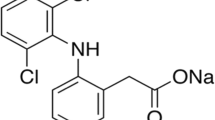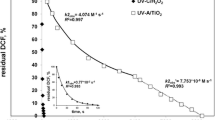Abstract
The oxidation of diclofenac (DCF), a non-steroidal anti-inflammatory drug and emerging water pollutant, with chlorine dioxide was investigated under simulated water disinfection conditions. The reaction kinetics as functions of the initial concentrations of DCF, different nitrogenous species, and different pE values were experimentally determined. The results demonstrated that DCF reacted rapidly with ClO2, where more than 75 % of DCF (≤3.00 μM) was removed by 18.94 μM ClO2 within 60 s. All of the reactions followed pseudo first-order kinetics with respect to DCF, and the rate constant, k obs, exhibited a significant decrease from 4.21 × 10−2 to 8.09 × 10−3 s−1, as the initial DCF concentration was increased from 1.00 to 5.00 μM. Furthermore, the degradation kinetics of DCF was clearly dependent on nitrogen-containing ion concentrations in the reaction solution. Ammonium and nitrite ions inhibited the DCF degradation by ClO2, whereas nitrate ion clearly initiated its promotion. In contrast, the inhibitory effect of NO2 − was more robust than that of NH4 +. When the values of pE were gradually increased, the transformation of NH4 + to NO2 −, and subsequently to NO3 −, would occur, the rate constants were initially decreased, and then increased. When NH4 + and NO2 − coexisted, the inhibitory effect on the DCF degradation was less than the sum of the partial inhibitory effect. However, when NO2 − and NO3 − coexisted, the actual inhibition rate was greater than the theoretical estimate. These results indicated that the interaction of NH4 + and NO2 − was antagonistic, while the coexistence of NO2 − and NO3 − was observed to have a synergistic effect in aqueous environments.



Similar content being viewed by others
References
Aguinaco A, Beltran FJ, Garcia-Araya JF, Oropesa AL (2012) Photocatalytic ozonation to remove the pharmaceutical diclofenac from water: influence of variables. Chem Eng J 189:275–282
Bae S, Kim D, Lee W (2013) Degradation of diclofenac by pyrite catalyzed Fenton oxidation. Appl Catal B Environ 134–135:93–102
Banks AT, Zimmerman HJ, Ishak KG, Harter JG (1995) Diclofenac-associated hepatotoxicity: analysis of 180 cases reported to the food and drug administration as adverse reactions. Hepatol (Baltimore, Md) 22:820–827
Deng Y, Ezyske CM (2011) Sulfate radical-advanced oxidation process (SR-AOP) for simultaneous removal of refractory organic contaminants and ammonia in landfill leachate. Water Res 45:6189–6194
Eddy RS, Joyce AP, Roberts S, Buxton TB, Liewehr F (2005) An in vitro evaluation of the antibacterial efficacy of chlorine dioxide on E. faecalis in bovine incisors. J Endod 31:672–675
Forrez I, Carballa M, Verbeken K, Vanhaecke L, Schlusener M, Ternes T, Boon N, Verstraete W (2010) Diclofenac oxidation by biogenic manganese oxides. Environ Sci Technol 44:3449–3454
Heberer T (2002) Tracking persistent pharmaceutical residues from municipal sewage to drinking water. J Hydrol 266:175–189
Hernando MD, Mezcua M, Fernandez-Alba AR, Barcelo D (2006) Environmental risk assessment of pharmaceutical residues in wastewater effluents, surface waters and sediments. Talanta 69:334–342
Hey G, Grabic R, Ledin A, la Cour Jansen J, Andersen HR (2012) Oxidation of pharmaceuticals by chlorine dioxide in biologically treated wastewater. Chem Eng J 185–186: 236–242
Huber MM, Korhonen S, Ternes TA, von Gunten U (2005) Oxidation of pharmaceuticals during water treatment with chlorine dioxide. Water Res 39:3607–3617
Ji Y, Zeng C, Ferronato C, Chovelon JM, Yang X (2012) Nitrate-induced photodegradation of atenolol in aqueous solution: kinetics, toxicity and degradation pathways. Chemosphere 88:644–649
Kolpin DW, Furlong ET, Meyer MT, Thurman EM, Zaugg SD, Barber LB, Buxton HT (2002) Pharmaceuticals, hormones, and other organic wastewater contaminants in U.S. streams, 1999–2000: a national reconnaissance. Environ Sci Technol 36:1202–1211
Li W, Lu S, Qiu Z, Lin K (2010) Clofibric acid degradation in UV254/H2O2 process: effect of temperature. J Hazard Mater 176:1051–1057
Lim MY, Kim JM, Ko G (2010) Disinfection kinetics of murine norovirus using chlorine and chlorine dioxide. Water Res 44:3243–3251
Miranda-García N, Suárez S, Sánchez B, Coronado JM, Malato S, Maldonado MI (2011) Photocatalytic degradation of emerging contaminants in municipal wastewater treatment plant effluents using immobilized TiO2 in a solar pilot plant. Appl Catal B Environ 103:294–301
Munoz I, Lopez-Doval JC, Ricart M, Villagrasa M, Brix R, Geiszinger A, Ginebreda A, Guasch H, de Alda MJL, Romani AM, Sabater S, Barcelo D (2009) Bridging levels of pharmaceuticals in river water with biological community structure in the llobregat river basin (Northeast Spain). Environ Toxicol Chem 28:2706–2714
Nadupalli S, Koorbanally N, Jonnalagadda SB (2011) Chlorine dioxide-facilitated oxidation of the azo dye amaranth. J Phys Chem A 115:11682–11688
Navalon S, Alvaro M, Garcia H (2008) Reaction of chlorine dioxide with emergent water pollutants: product study of the reaction of three beta-lactam antibiotics with ClO2. Water Res 42:1935–1942
Nélieu S, Shankar MV, Kerhoas L, Einhorn J (2008) Phototransformation of monuron induced by nitrate and nitrite ions in water: contribution of photonitration. J Photochem Photobiol A Chem 193:1–9
Nelieu S, Perreau F, Bonnemoy F, Ollitrault M, Azam D, Lagadic L, Bohatier J, Einhorn J (2009) Sunlight nitrate-induced photodegradation of chlorotoluron: evidence of the process in aquatic mesocosms. Environ Sci Technol 43:3148–3154
Nie E, Yang M, Wang D, Yang X, Luo X, Zheng Z (2014) Degradation of diclofenac by ultrasonic irradiation: kinetic studies and degradation pathways. Chemosphere 113:165–170
Oaks JL, Gilbert M, Virani MZ, Watson RT, Meteyer CU, Rideout BA, Shivaprasad HL, Ahmed S, Chaudhry MJI, Arshad M, Mahmood S, Ali A, Khan AA (2004) Diclofenac residues as the cause of vulture population decline in Pakistan. Nature 427:630–633
Ravalason H, Bertaud F, Herpoël-Gimbert I, Meyer V, Ruel K, Joseleau JP, Grisel S, Olivé C, Sigoillot JC, Petit-Conil M (2012) Laccase/HBT and laccase-CBM/HBT treatment of softwood kraft pulp: impact on pulp bleachability and physical properties. Bioresour Technol 121:68–75
Schwaiger J, Ferling H, Mallow U, Wintermayr H, Negele RD (2004) Toxic effects of the non-steroidal anti-inflammatory drug diclofenac: Part I. Histopathological alterations and bioaccumulation in rainbow trout. Aquat Toxicol 68:141–150
Shankar MV, Nelieu S, Kerhoas L, Einhorn J (2007) Photo-induced degradation of diuron in aqueous solution by nitrites and nitrates: kinetics and pathways. Chemosphere 66:767–774
Shankar MV, Nélieu S, Kerhoas L, Einhorn J (2008) Natural sunlight-induced photo-degradation of phenylurea herbicides in water. Chemosphere 71:1461–1468
Shu Z, Bolton JR, Belosevic M, Gamal El Din M (2013) Photodegradation of emerging micropollutants using the medium-pressure UV/H2O2 advanced oxidation process. Water Res 47:2881–2889
Soufan M, Deborde M, Legube B (2012) Aqueous chlorination of diclofenac: kinetic study and transformation products identification. Water Res 46:3377–3386
Spongberg AL, Witter JD (2008) Pharmaceutical compounds in the wastewater process stream in Northwest Ohio. Sci Total Environ 397:148–157
Tian F, Qiang ZM, Liu C, Zhang T, Dong BZ (2010) Kinetics and mechanism for methiocarb degradation by chlorine dioxide in aqueous solution. Chemosphere 79:646–651
Triebskorn R, Casper H, Heyd A, Eikemper R, Köhler HR, Schwaiger J (2004) Toxic effects of the non-steroidal anti-inflammatory drug diclofenac: Part II. Cytological effects in liver, kidney, gills and intestine of rainbow trout (Oncorhynchus mykiss). Aquat Toxicol 68:151–166
Wang P, He YL, Huang CH (2010) Oxidation of fluoroquinolone antibiotics and structurally related amines by chlorine dioxide: reaction kinetics, product and pathway evaluation. Water Res 44:5989–5998
Wang P, He YL, Huang CH (2011) Reactions of tetracycline antibiotics with chlorine dioxide and free chlorine. Water Res 45:1838–1846
Wang Y, Liu H, Liu G, Xie Y (2014) Oxidation of diclofenac by aqueous chlorine dioxide: identification of major disinfection byproducts and toxicity evaluation. Science of The Total Environment 473–474: 437–445
Xu L, Cseko G, Petz A, Horvath AK (2014) Kinetics and mechanism of the oxidation of pentathionate ion by chlorine dioxide in a slightly acidic medium. J Phys Chem A 118:1293–1299
Zhang Y, Geissen SU, Gal C (2008) Carbamazepine and diclofenac: removal in wastewater treatment plants and occurrence in water bodies. Chemosphere 73:1151–1161
Zhang A, Li Y, Song Y, Lv J, Yang J (2014) Characterization of pharmaceuticals and personal care products as N-nitrosodimethylamine precursors during disinfection processes using free chlorine and chlorine dioxide. J Hazard Mater 276:499–509
Acknowledgments
This work was supported by the National Natural Science Foundation of China (Nos. 21377031 and 81401470), the Scientific Research Project of Guangdong Province (No. 2013B020800009), the Natural Science Foundation of Henan Province (Nos. 132300410158 and 112300410104), and the Science and Technology Research Key Project of Education Department of Henan Province (Nos. 13A610516 and 13A610853).
Author information
Authors and Affiliations
Corresponding author
Additional information
Responsible editor: Roland Kallenborn
Rights and permissions
About this article
Cite this article
Wang, Y., Liu, H., Liu, G. et al. Oxidation of diclofenac with chlorine dioxide in aquatic environments: influences of different nitrogenous species. Environ Sci Pollut Res 22, 9449–9456 (2015). https://doi.org/10.1007/s11356-015-4118-2
Received:
Accepted:
Published:
Issue Date:
DOI: https://doi.org/10.1007/s11356-015-4118-2




